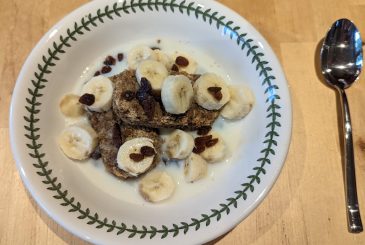Including enough iron in your diet is vital for good health and performance. Hatty Bates, Performance Nutritionist for British Rowing, shares advice
Iron is an essential mineral which is needed for several physiological processes. Evidence suggests that low levels of iron can negatively affect our ability to train and perform, particularly during aerobic activity. We’ll discuss the importance of iron for rowers as well as provide examples of iron-rich food and simple ways to increase the iron content of your diet.
Why is iron important?
Iron plays an important role in making haemoglobin. Haemoglobin is a protein found in red blood cells that transports oxygen around the body. Therefore, insufficient iron levels may result in reduced oxygen transportation to the working muscles. This makes it harder to train at a high intensity for the full duration of a training session.
The brain also relies on oxygen delivery to be able to concentrate.
Finally, iron is also needed to support a healthy immune system and to avoid frequent bouts of colds and infections.
How much iron do I need and what food can I get it from?
The recommended daily intake for iron is 8.7mg for males and 14.8mg for females. Females require a higher iron intake compared to males due to monthly menstruation. Although the exact amounts are still unknown, rowers engaging in multiple training sessions per week may have higher dietary iron requirements than this. This is due to athletes having more avenues for iron losses such as through sweating, gastrointestinal tract disturbances and a higher rate of rate blood cell turnover.
“Aim to eat iron-rich foods alongside foods high in vitamin C”
When it comes to iron-rich food, it is important to acknowledge that there are two types of iron: haem and non-haem iron. Haem iron is typically found in meat sources such as beef, lamb, and poultry, whereas non-haem iron is derived from plant sources such as spinach, kidney beans, and dried figs. In general, haem iron is more efficiently absorbed compared to non-haem iron. For example, approximately 15-35% of haem iron in a single meal is absorbed, whereas only 2-20% of non-haem iron is absorbed. Therefore, vegetarian and plant-based rowers may need to plan their iron intake a bit more carefully.
Haem iron sources
| Food | Preparation and portion size | Iron (mg) |
| Beef | Minced, stewed (100g) | 2.7 |
| Lamb | Leg, roasted (100g) | 1.8 |
| Pork | Sausages, grilled (100g) | 1.3 |
| Chicken | Roast, light meat (100g) | 0.4 |
| Tuna | Canned in brine (100g) | 1.0 |
| Sardines | Canned in oil, drained (100g) | 2.3 |
| Anchovies | Canned in oil, drained (100g) | 4.1 |
Non-haem iron sources
| Food | Preparation and portion size | Iron (mg) |
| Baked beans | In tomato sauce (100g) | 1.4 |
| Kidney beans | Canned, drained (100g) | 2.0 |
| Branflakes | 50g | 12.2 |
| Tofu | Steamed, fried (100g) | 3.5 |
| Spinach | Boiled (100g) | 1.6 |
| Sesame seeds | 30g | 3.1 |
| Apricots | Dried (60g) | 2.5 |
What you eat alongside iron-rich food could also affect how much iron is absorbed. In general, aim to eat iron-rich foods alongside foods high in vitamin C such as orange juice, bell-peppers, broccoli, and kiwi fruit. Vitamin C has been shown to enhance iron absorption. On the other hand, food containing polyphenols and calcium such as tea, coffee and dairy products could hinder the amount of iron absorbed from a meal.
“Females, individuals who train regularly and those following a plant-based diet may be at an increased risk of iron deficiency”
Tips for increasing your iron content
- Have lean meat, poultry, or seafood as part of a salad or in sandwiches.
- Include green leafy vegetables such as spinach or broccoli in main meals.
- If you follow a plant-based diet, eat iron-rich plant foods (e.g. baked beans, tofu, lentils) regularly throughout the day.
- Drink a glass of orange or grapefruit juice with breakfast to maximise iron absorption from breakfast cereal.
- Add raisins, dried apricots, and nuts to porridge to increase the iron content. These examples could also be had as snacks throughout the day.
- Avoid drinking strong tea or coffee at the same time as iron rich foods.
How do I know if I have iron depletion?
If your iron levels are low, you may start to feel fatigued or lethargic, look pale or experience shortness of breath.
If you start to experience these symptoms consult with a doctor or registered dietitian to determine if you are iron deficient and whether iron supplementation would be beneficial. If you are an athlete, remember to check your supplements on Global DRO (for medication e.g. Ferrograd C) and the Informed Sport website to avoid breaching the anti-doping rules.
Summary
Iron is an essential mineral for all rowers due to its role in oxygen transportation, energy production and supporting the immune system.
Females, individuals who train regularly and those following a plant-based diet may be at an increased risk of iron deficiency due to more avenues for iron loss and less iron being absorbed from plant-based food. In general, 8.7mg and 14.8mg of iron should be consumed by males and females, respectively. Aim to consume iron-rich food alongside sources of vitamin C to enhance iron absorption.
This article was first published in September 2021.










